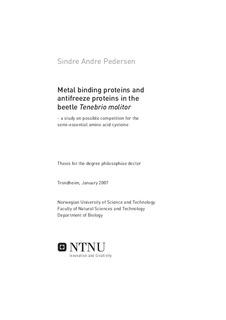| dc.contributor.author | Pedersen, Sindre Andre | nb_NO |
| dc.date.accessioned | 2014-12-19T13:11:09Z | |
| dc.date.available | 2014-12-19T13:11:09Z | |
| dc.date.created | 2007-05-04 | nb_NO |
| dc.date.issued | 2007 | nb_NO |
| dc.identifier | 122337 | nb_NO |
| dc.identifier.isbn | 978-82-471-0363-0 | nb_NO |
| dc.identifier.uri | http://hdl.handle.net/11250/244561 | |
| dc.description.abstract | In their natural environment animals are confronted by both physical (eg. extreme temperatures, desiccation) and chemical stressors (e.g. pollutants). Stress may be defined as a condition that is evoked in an organism by one or more environmental factors that bring the organism near to or over the edges of its ecological niche (van Straalen 2003). Various defence systems exist to cope with different forms of stress and restore homeostasis. Often, production of various proteins or enzymes are involved in these defence systems (Korsloot et al. 2004). Since an organism’s resources may be considered to be limited, the ability to restore homeostasis depends on the severity of the different forms of stress it experiences. It has been proposed that pollutants present in the environment may alter the ability to respond to climatic stressors like e.g. low temperature, desiccation (Holmstrup 2002).
This work deals with the possible consequences of combined stress from metal exposure and low temperature in cold hardy insects. Many of these insects produce so called antifreeze proteins that protect them from lethal freezing. Metallothioneins are metal binding proteins that are considered to be important in detoxification when animals are exposed to metals. Metallothioneins and most forms of antifreeze proteins from insects are known to contain unusually high amounts cysteine. Cysteine is considered to be semi-essential, since it must be derived from the essential amino acid methionine (Choen 2004). Induction of one of these two types of proteins may potentially deplete the cysteine pool and thus reduce the capacity to produce the other type. Alternatively, the animals might have evolved other structures to avoid a potential competition for cysteine. The purpose of the present work was to explore these possible scenarios. | nb_NO |
| dc.language | eng | nb_NO |
| dc.publisher | Fakultet for naturvitenskap og teknologi | nb_NO |
| dc.relation.ispartofseries | Doktoravhandlinger ved NTNU, 1503-8181; 2007:17 | nb_NO |
| dc.relation.haspart | Zachariassen, K.E.; Kristiansen, E; Pedersen, S.A.. Inorganic ions in coldhardiness. Cryobiology. 48(2): 126-133, 2004. | nb_NO |
| dc.relation.haspart | Pedersen, S.A.; Kristiansen, E; Hansen, B.H; Andersen, R.A; Zachariassen, K.E.. Cold hardiness in relation to trace metal stress in the freeze-avoiding beetle Tenebrio molitor. Journal of Insect Physiology. 52(8): 846-853, 2006. | nb_NO |
| dc.relation.haspart | Pedersen, S.A.; Kristiansen, E; Andersen, R.A; Zachariassen, K.E.. Cadmium exposure of the beetle Tenebrio molitor (L): Internal distribution of Cd and induction of a Cd-binding protein in the gut content. . | nb_NO |
| dc.title | Metal binding proteins and antifreeze proteins in the beetle Tenebrio molitor: a study on possible competition for the semi-essential amino acid cysteine | nb_NO |
| dc.type | Doctoral thesis | nb_NO |
| dc.contributor.department | Norges teknisk-naturvitenskapelige universitet, Fakultet for naturvitenskap og teknologi, Institutt for biologi | nb_NO |
| dc.description.degree | PhD i biologi | nb_NO |
| dc.description.degree | PhD in Biology | en_GB |
